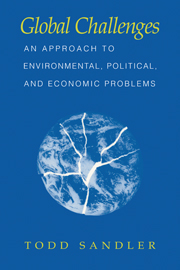Book contents
- Frontmatter
- Contents
- List of tables and figures
- Preface
- Acknowledgments
- 1 Apocalypse now or never?
- 2 Global interdependencies: Basic tools and principles
- 3 For our children's children
- 4 Global house
- 5 Architecture of institutions
- 6 Change we must: Evolutionary concerns
- 7 Equity among nations?
- 8 Near horizons
- References
- Author index
- Subject index
Preface
Published online by Cambridge University Press: 05 June 2012
- Frontmatter
- Contents
- List of tables and figures
- Preface
- Acknowledgments
- 1 Apocalypse now or never?
- 2 Global interdependencies: Basic tools and principles
- 3 For our children's children
- 4 Global house
- 5 Architecture of institutions
- 6 Change we must: Evolutionary concerns
- 7 Equity among nations?
- 8 Near horizons
- References
- Author index
- Subject index
Summary
During the past fifty years, momentous changes in economic activities, technology, warfare, communications, information systems, and population have drawn the world's countries into a global community. Countries' borders, once secured through armies and artillery, are now invaded daily by pollutants, unleashed by economic activities at home and abroad. We live in an era during which the side effects of these activities have surpassed limits, beyond which stresses placed on the planet's ecosystems lead to permanent deterioration. In aggregation, economic activities have degraded the troposphere, stratosphere, high seas, rivers, watersheds, forests, and airsheds. The collective pursuit of economic well-being has thinned the stratospheric ozone shield and has heated the atmosphere. As little as thirty years ago, terms like ozone hole, acid rain, nuclear meltdown, nuclear-weapon proliferation, international terrorism, global warming, desertification, and biodiversity were foreign to most people. Traditionally, the next generation's well-being improves compared with that of preceding generations as knowledge, capital, and other assets are passed down. If environmental deterioration continues to destroy the earth's assets, this tradition will end.
Will these problems continue unabated? Will future cities be encapsulated in domes of concrete, steel, and glass, where a day in the country will involve watching a video and where residents look nostalgically out on an inhospitable environment? Significant challenges confront the global community, where actions taken today will limit the options of generations to come. With the recognition of these challenges have come pleas for larger decision-making jurisdictions in the form of regional and global governments to safeguard the environment and maintain the peace.
Information
- Type
- Chapter
- Information
- Global ChallengesAn Approach to Environmental, Political, and Economic Problems, pp. xiii - xviPublisher: Cambridge University PressPrint publication year: 1997
